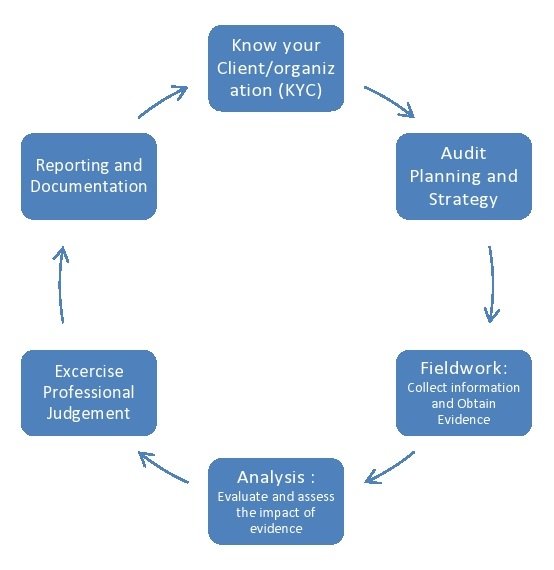Auditing cycles are important part of financial statement auditing. They are the means by which an auditor obtains sufficient, competent evidential matter to form an opinion on a company’s financial information. An audit evidence cycle begins with the identification of risks and ends with the issuance of an auditor’s report. In this post, we will look at the four phases involved in making an audit cycle.
- How many audit cycles are there?
- What is the importance of an audit cycle?
- What are the four phases of an audit cycle?
- How does an auditor identify risks during the first phase of an audit cycle?
- What is the importance of an audit plan during Phase 2?
- What is the importance of an audit execution during Phase 3?
- What factors are involved in Phase 4?
- What is the difference between a qualified opinion and an unmodified opinion?
- What is the importance of an audit finding report?
- What is the difference between an unqualified opinion and a qualified opinion?
- In conclusion on financial statements and the audit process
How many audit cycles are there?
The number of audit cycles depends on the size of the company. For example, a large entity, with more potential company issues would have more audit cycles than a small one. There are four types of audit cycles for companies- annual, quarterly, monthly, and weekly. Every financial statement must be audited within these given time constraints. This ensures that they are accurate and reliable.
What is the importance of an audit cycle?
The importance of an audit cycle can be understood by looking at its four parts- planning, execution, evaluation, and reporting. If one part is not carried out then it would affect the entire process. For example, if there is no proper planning before starting work then it would lead to a delay in reporting causing a huge loss for the company and its services.
What are the four phases of an audit cycle?
1. Identification of risks: The auditor identifies all possible financial statement-related risks during this phase. These include such factors as management’s ability to generate sufficient cash flows and profitability; accuracy and completeness of records; the effectiveness of internal control over assets and liabilities; and availability of adequate accounting records on a timely basis for the audit.
2. Audit planning: Based on the possible risks, the auditor plans his approach to addressing them during this phase. He also determines the evidence required to complete the audit successfully. If he does not have enough evidence of earnings or revenues of a firm then it would be difficult to form an opinion on the financial statements.
3. Audit execution: Here, the auditor plans and executes his audit based on the plan made in Phase 1. He makes inquiries of company employees, examines records, obtains documents, etc., to determine the accuracy of information being presented by management. The main focus is to ensure that transactions are correctly recorded.
4. Evaluation and reporting: This is the final stage of an audit cycle in which the auditor formulates an opinion on financial statements using evidence gathered during Phase 3. He presents his findings in a report, following relevant accounting processes and standards. The company can issue it to its public with an unmodified opinion if all risks are successfully managed by management and the internal control system. On the other hand, if there were material misstatements in financial statements then it would be issued as a qualified opinion.

How does an auditor identify risks during the first phase of an audit cycle?
He identifies various risks that can impact financial statements such as inadequate accounting cycle of records (Double Declining Balance Method); errors and irregularities; non-compliance with laws and regulations; and variance in accounting practices among similar companies.
What is the importance of an audit plan during Phase 2?
An internal audit process plan is a document that gives all the necessary details about how auditors will gather evidence from different sources to form an opinion on financial statements. It includes pertinent information such as scope, timing, types of evidence needed, approach to be followed, etc.
What is the importance of an audit execution during Phase 3?
It is critical to complete the tasks of executing the plan made in phase 1 of an audit cycle. If any part of it is missed then there are chances of delays in reporting leading to losses for the company. The evidence obtained must be relevant and sufficient enough for making a reliable opinion.
What factors are involved in Phase 4?
What factors go into the evaluation and reporting during Phase 4? The main factor that goes into the evaluation and reporting part of an audit cycle is obtaining evidence that enables auditors to form their opinions on financial statements. Evidence should be adequate, relevant, and reliable for auditors to take any further corrective actions if required.
What is the difference between a qualified opinion and an unmodified opinion?
If auditors have serious doubts about the company’s ability to continue as a going concern, or if they think that financial statements are materially misstated then it would result in a qualified opinion. On the other hand, an unmodified opinion is given if financial statements present a fair view of the company’s financial position.
Audit finding reports are used to inform stakeholders about problems that auditors have found in financial statements.
What is the importance of an audit finding report?
Audit finding reports are used to inform stakeholders about problems that auditors have found in financial statements. It gives a warning about significant risks and recommends actions by management to mitigate the same. Such disclosure ensures accountability and transparency of operations.
Audit finding reports are important to ensure credibility in safe investment and lending decisions. They also help in effective governance by inhibiting unethical practices in business operations.
What is the difference between an unqualified opinion and a qualified opinion?
An unqualified opinion is given if auditors have not found any accounting errors or significant risks in financial statements. In a qualified opinion, auditors have found errors or high risks but do not think those will lead to material misstatement in the company’s financial position.
In an unqualified opinion, the audit report concludes that financial statements have been prepared according to generally accepted accounting principles (GAAP). Whereas, for a qualified opinion, auditors have noted that they cannot find evidence to form a sufficient basis for an audit opinion on financial statements.
In conclusion on financial statements and the audit process
Financial statements play a crucial role in our economy as they give important information about companies’ performance, risks, and investments. So auditing financial statements is a continuous process and very important work as it helps all stakeholders make decisions using accurate information. In order to carry out this task successfully, each and every phase of the internal controls system must be examined thoroughly. Since the four phases – planning phase, execution, evaluation, and reporting – are so closely interrelated, a delay in one might lead to a huge loss for the company as well as the auditor’s firm. Therefore the auditor must ensure substantive analytical procedures through journal entries of sales transactions in the sales cycle. All this makes financial statement auditing very challenging work but also equally rewarding.

Dean Emerick is a curator on sustainability issues with ESG The Report, an online resource for SMEs and Investment professionals focusing on ESG principles. Their primary goal is to help middle-market companies automate Impact Reporting with ESG Software. Leveraging the power of AI, machine learning, and AWS to transition to a sustainable business model. Serving clients in the United States, Canada, UK, Europe, and the global community. If you want to get started, don’t forget to Get the Checklist! ✅
